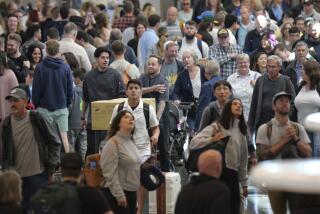Summertime . . . and Gas Prices Are Bound to Rise : Travel: Americans are expected to hit the highways and airports in record numbers.
- Share via
Vacationers may pay more for gasoline this summer, while leisure and business travelers are expected to crowd the nation’s highways and airports in record numbers, travel industry experts said Wednesday.
Travel on U.S. highways is expected to be 2% higher than last summer--with the West a favorite destination--because people are feeling increasingly confident about the economy, according to one travel industry survey. The airlines expect more than 160 million passengers this summer.
Meanwhile, planned business trips are up by almost 22%, according to research released Wednesday by the American Automobile Assn. and the Travel Industry Assn. of America, a promotional and research trade group for the U.S. travel industry.
All this extra fuel consumption could push up prices even higher this spring and summer. In May, prices for unleaded gasoline leaped more than 6 cents to a national average of almost $1.20 a gallon.
Prices are likely to go up, said Mike Morrissey, an AAA spokesman, “but whether it’s a penny [or] two pennies, it’s difficult to say. We’re not in a crisis mood, not anticipating shortages, gas lines, this sort of thing.”
Trilby Lundberg, publisher of the Los Angeles-based Lundberg Letter, which tracks prices at the pump, also sees a chance for higher fuel costs.
“Some further increases could be expected. But we’re not certain of that,” Lundberg said. She credited higher gasoline prices in recent weeks to higher crude oil prices this spring, as well as what appears to be higher recent demand for gasoline compared with last year.
On the other hand, modest gas hikes might not have much effect on a vacationing public willing to spend a bit more for luxury on a summer trip this year. On average, U.S. travelers expect to spend 9% more this summer on their longest vacation of the year, according to the AAA report.
As for the airlines, “If you’re going to travel this summer, make your reservations now, because it may be hard to find a seat,” warned David Swierenga, chief economist at the Air Transport Assn., trade group of U.S.-scheduled airlines.
Swierenga said that the airlines expected a record 9.3 million passengers over the Memorial Day weekend alone. In all, this summer’s air travel is expected to be 50% higher than it was 10 years ago, he said. He also predicted a 5% growth in air traffic through the rest of the year, spurred by a healthy U.S. economy and stable airline fares.
The West will see the most motorists on the road this summer--with 7.2 million travelers, compared with 4.7 million in the Midwest and 4.2 million in the Southeast, according to the AAA report.
The AAA also estimates that 80% of this summer’s vacations will be taken by car, 16% by plane and 4% by train, cruise ship, bus or other means.
Recent gas price hikes have come from rising crude oil prices, in turn brought on by a variety of factors, including uncertainty about supplies from Middle East oil states. It is probable that only a similar disruption this summer could bring dramatically higher gasoline prices, said Edward H. Murphy, director of finance, accounting and statistics at the American Petroleum Institute.
“It’s very unlikely that there would be huge price spikes because of huge demand increases” by vacation drivers, Murphy said. “But you do always have the possibility of an increase in crude oil prices . . . if you look at the volatility of many oil-producing countries.”
Gasoline prices last went up just before the first of the year on concern about possible shortages of reformulated gasoline, which federal regulators mandated for roughly 30% of the nation’s drivers beginning in January. But prices dropped dramatically when it was discovered there was really an oversupply.
Some confusion has recently resulted from an AAA report that prices at the pump over Memorial Day weekend will be the highest in a decade. Indeed, they are currently--in absolute dollars. Still, when adjusted for inflation, using 1987 dollars, U.S. Department of Energy statistics show that gas prices are actually lower now.
In 1987 dollars, according to the DOE, unleaded regular averaged $1.27 a gallon in 1985. This year, the same gasoline will cost 87.6 cents in 1987 dollars.
(BEGIN TEXT OF INFOBOX / INFOGRAPHIC)
Paying More at the Pump
Higher crude oil prices in April have pushed gasoline prices up a whopping 7 cents in May. National average price per gallon of self-serve regular unleaded:
1995: $1.196
*
Source: American Automobile Assn.
More to Read
Sign up for The Wild
We’ll help you find the best places to hike, bike and run, as well as the perfect silent spots for meditation and yoga.
You may occasionally receive promotional content from the Los Angeles Times.






